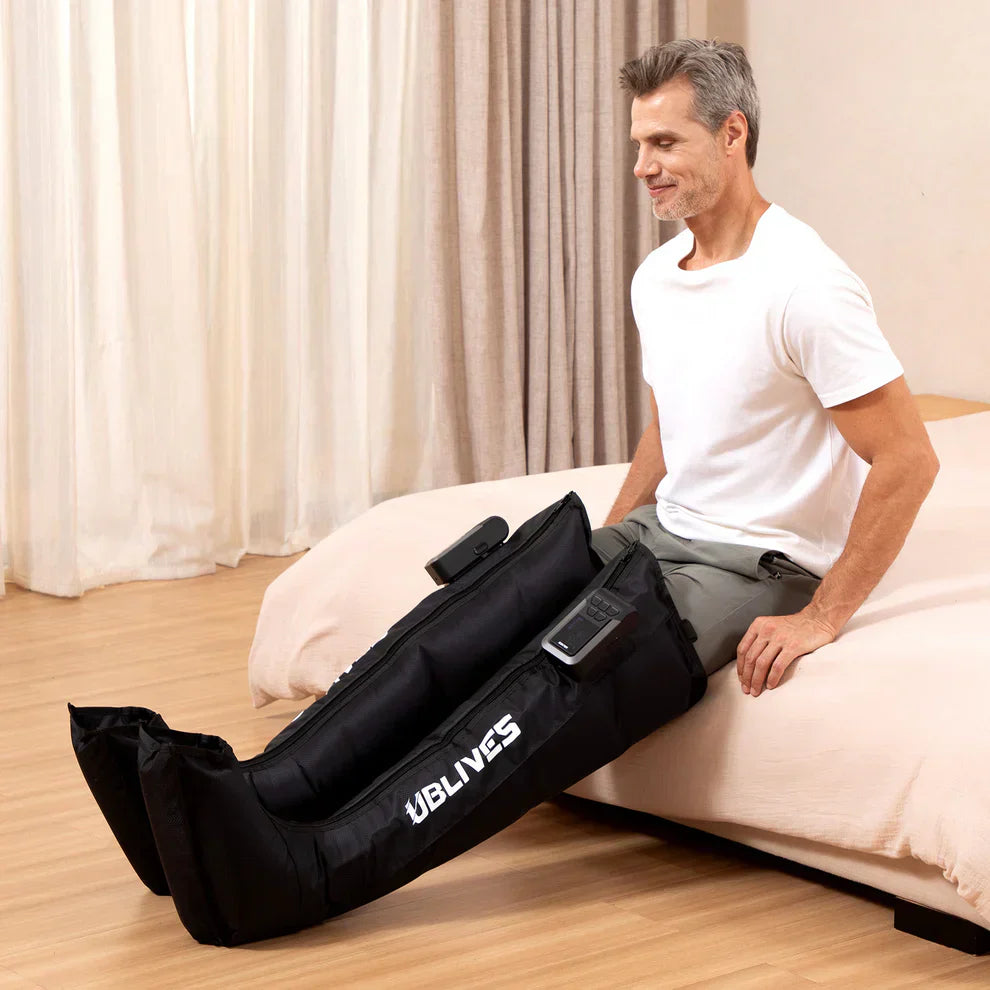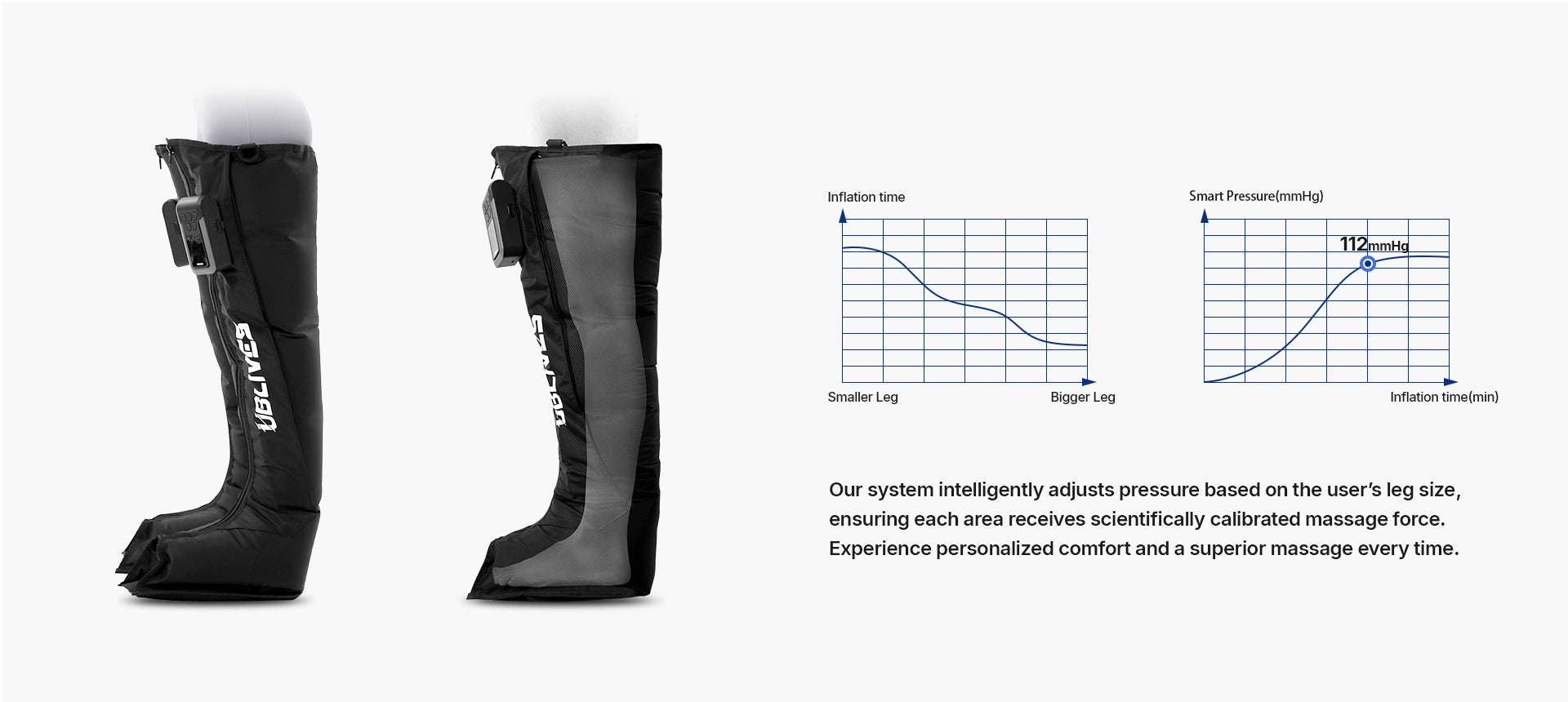
How Leg Compression Enhances Recovery and Reduces Fatigue
Studies have shown that compression boots are effective in eliminating waste products such as lactic acid, helping to relieve soreness and fatigue. Over 80% of athletes report faster recovery times with compression gear. Have you ever wondered about the role of leg compression in athletic recovery? This article will show you how leg compression can improve performance and reduce fatigue!
What is Leg Compression and Why Is It Important?
Leg compression is the application of gentle pressure to the legs. It helps the body recover by promoting blood flow and relieving muscle fatigue. This involves the use of special tools such as recovery boots or compression sleeves.
When you exercise, your muscles produce waste products such as lactic acid. These wastes can build up and leave you feeling sore or fatigued. Pressurizing your legs helps remove these wastes faster. Leg compression is not just for athletes. It's also great for people with tired, swollen legs or poor blood flow. This is because it improves blood flow and provides oxygen and nutrients to the muscles. This eliminates swelling and soreness after standing or sitting for long periods of time. Compression gear also stabilizes the muscles and reduces the vibrations that cause pain.
Studies have shown that lactic acid in the blood drops faster during leg compression than at rest. Check out the table below:
Measurement |
Normatec Recovery |
Active Recovery |
Passive Recovery |
|---|---|---|---|
Blood Lactate Pre-Bike Ride |
1.70 mM/L |
1.70 mM/L |
1.70 mM/L |
Blood Lactate Post-Bike Ride |
9.94 mM/L |
9.94 mM/L |
9.94 mM/L |
Post Recovery Blood Lactate |
8.38 mM/L |
7.49 mM/L |
12.61 mM/L |
Benefits of Leg Compression for Athletic Performance
Leg compression helps you recover faster and feel less tired. It improves blood flow, giving muscles oxygen and nutrients to heal. This also clears waste like lactate, which causes soreness and fatigue. Studies prove compression gear improves recovery. For example:
Performance Metric |
What It Does |
|---|---|
Less swelling |
|
Better blood flow |
Sends more oxygen to muscles for healing. |
More hemoglobin |
Helps muscles get oxygen quicker. |
Easier movement |
Improves flexibility and range of motion. |
Less pain |
Makes muscles hurt less after exercise. |
Less muscle tiredness |
Helps muscles feel stronger after workouts. |
Promotes relaxation |
It helps your body and mind recover better. |
Leg compression not only aids in recovery but also builds endurance and prevents injuries. It keeps the muscles stable and stops the vibrations that cause soreness. This keeps you from feeling fatigued during longer workouts. More than 70% of athletes report that compression improves their performance and 80% say it speeds recovery.
It also reduces the risk of injury by supporting muscles and improving blood flow. 90% of athletes believe compression stockings prevent further injury. Wearing them regularly can prevent leg injuries, especially for runners and endurance athletes.

How Leg Compression Helps Recovery
Improve Blood Flow
Leg compression helps blood flow by gently pressing on the legs. This pressure helps venous blood flow back to the heart faster. Better blood flow provides more oxygen and nutrients to the muscles, speeding recovery. For example, one study showed a 42% increase in oxygenated hemoglobin and a 138% increase in total hemoglobin after using compression.
A study by Diesch et al (2024) compared compression gear to treatments such as Kinesio tape. The study found that compression gear reduced swelling (p = 0.009) and improved blood flow in the tissues.
Reducing Swelling and Muscle Pain
Swelling and soreness can occur after strenuous exercise or prolonged standing. Pressurizing the legs helps to flush out waste products from the muscles. This process removes substances such as lactates that cause soreness. Studies have shown that lactic acid in the blood drops faster during leg presses than at rest.
Helps Muscles Stay Strong
Leg compression keeps your muscles stable while you recover. This stabilization stops the vibrations that can hurt your muscles and cause soreness. Studies have shown that compression therapy improves muscle performance and reduces fatigue. For example, research has found that Normatec compression therapy reduces blood lactate levels and promotes active recovery.
Another study showed that the tibialis anterior muscles were stronger after using compression therapy. This proves that leg compression helps the muscles recover and prepare them for the next activity.
Picking the Best Compression Gear
Consider your needs first. Do you want to reduce swelling, improve blood flow, or recover from a workout? Different needs require different graded compression, so define your needs and make sure your gear fits well and has the right compression.
A compression boot like the Ublives® SoleFlux Relax compression leg massager covers the entire leg and has different compression levels, it is a lightweight product easy to carry around and can be used anywhere. These boots are perfect for a full recovery. If you only need relief in one area, try cuffs or stockings.
The best time to use compression optimally is to put it on immediately after exercise to remove waste and reduce swelling. Intermittent Continuous Pneumatic Compression (ISPC) mimics the way muscles naturally pump blood to remove waste through the lymphatic system. For best results, wear your compression gear for 20-30 minutes a day.
Mixing compression with other recovery methods
Light activity such as stretching or walking improves blood flow and works better with compression therapy.
Drinking water and massage also help. Staying hydrated helps flush out waste, while massage relaxes tight muscles. Tools such as vibrating foam rollers or massage pads can make muscles feel better. Combine these methods to create a strong recovery program.

Scientific Evidence Supporting Leg Compression
Research on recovery and fatigue reduction
Researchers tested intermittent continuous pneumatic compression (ISPC). Participants performed eight rounds of intense cycling and then rested or used ISPC. The results showed that ISPC improved cardiac recovery and reduced leg swelling.
Exercise experts recommend compressing the legs to speed recovery. Cochrane et al. (2013) found that pneumatic compression accelerated muscle healing after a hard workout. wink and Williamson (2018) compared compression equipment and clothing. Both were effective in reducing soreness and fatigue.
This was confirmed by a meta-analysis conducted by Engel et al. This analysis showed that compression garments reduce soreness and fatigue by improving blood and lymphatic flow. This explains why athletes and fitness enthusiasts love leg compression garments.
FAQ
How Should I Use Leg Compression For Recovery?
Use leg compression after workouts or standing for a long time. Wear it for 20–30 minutes daily to help blood flow.
Can Leg Compression Help With Varicose Veins?
Yes, leg compression helps blood move better, easing vein pressure. This can reduce swelling and pain from varicose veins. Compression boots like the SoleFlux Relax are made to help with these problems.
Is Leg Compression Safe For Everyone?
Leg compression is safe for most people, including athletes and tired legs. But people with serious blood flow issues or health problems should ask a doctor first. Always follow the usage instructions carefully.
How Does Leg Compression Compare To Other Recovery Methods?
Leg compression works as well as active recovery to lower lactate. It also works great with stretching and drinking water. Using compression with light activity helps you recover faster than just resting.
What Makes The Ublives® Soleflux Relax Special?
The SoleFlux Relax has five pressure levels, and three massage modes, and is easy to carry. It adjusts pressure smartly and fits comfortably. With FDA approval and a 90-day trial, it’s a great choice for quick recovery and less tiredness.
